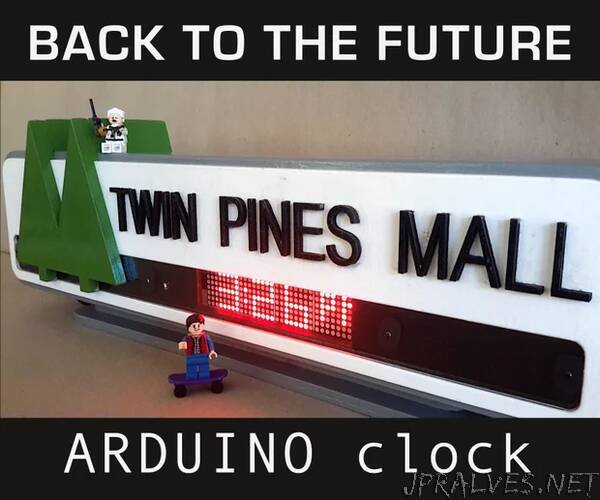
“Clocks are one of the main themes in “Back to the Future” - and also some of my favorite items for building replica props. Previously, I built three of those clocks, the one in the Time Circuits, the Harold Lloyd clock (as seen in the beginning of part I in Doc’s house), and one with Marty and the Doc standing in front of the clock face (based on a photo featured in BTTF part III).
Part I of BTTF also features another important clock which is part of the “Twin Pines Mall” sign (which, after Marty changed the timeline, became the “Lone Pine Mall”). This is the one I’m building here.
The electronics is built around an Arduino Nano. When bought from a Chinese supplier, the total cost of the electronics components should be below $20.
The time is displayed on a 8x32 LED array, based on the MAX7219 driver IC - this looks rather close to the display in the original movie prop. The differences are that in the original movie prop the colon is not exactly aligned with the grid of the dot matrix, and the “AM”/”PM” displays use a smaller dot matrix). But for my purposes this is close enough.
For the real time clock (RTC), I am using the module DS3231 which I also used previously in the Time Circuits. This clock is very precise and it runs for years with a CR2032 battery. There is, however, one problem with this module, related to the charging circuit which is supposed to be able to charge a rechargeable battery. As discussed in detail on this web page, the charging circuit would do damage to both a rechargeable battery or a non-rechargeable battery. So, the suggested solution is to simply remove a resistor (as indicated in the image) and to operate the module with a (non-rechargeable) CR2032 battery - this worked in my previous projects, and I’m doing this here again.
I also add a light dependent resistor (LDR) to the circuit, so the clock can adjust the LED intensity based on the surrounding brightness.
This is all that is needed:
- Arduino Nano (an Arduino Uno would work too)
- RTC module DS3231 (modified as desribed above) and CR2032 battery
- 8x32 LED module with MAX7219 driver
- light-dependent resistor (LDR) and one 10k resistor
- 2 momentary push button switches (to set the time: hours/minutes)
- a 6cm x 8cm PCB (or a breadboard)
- wood, acrylics (as described below)”
